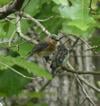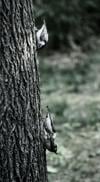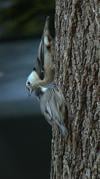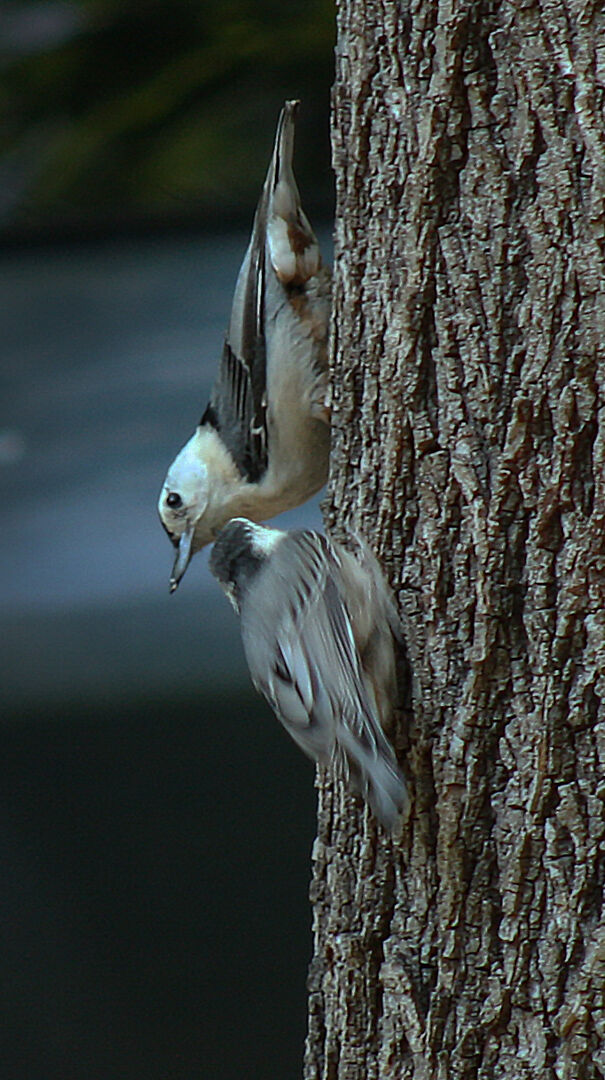After writing about squirrels and hawks starting new families a while ago, I expected to have reported on their reproductive success by now. While the squirrel brood did well — three spunky youngsters — the hawk tale sadly turned into a mystery when the adults apparently abandoned their nest after at least one chick had hatched (for details, go to my blog, wildideas.us). But the seasons march on, and by now, I have been able to observe the reproductive ups and downs of several other bird species.
As a year-round resident, the northern cardinal has an early start in nesting, before migrant species arrive, so I was not surprised that the first fledgling I saw this year was a cardinal. Its parents had attracted my attention by loudly chasing off a pair of curious, rambunctious young squirrels in a nearby tree.
By the end of May, a brood of eastern bluebirds started fledging from a cavity in the cedar siding of the house I share with the property owner, Julia. Woodpeckers had banged out a knot, and the bluebird pair had finished the refurbishing. Julia saw what she thought was their first fledgling fly from that side of the house. It landed several yards away in a large white oak that we can see easily from our upstairs screened porch. The chick looked a far cry from the elegant thrush it would become as an adult, but the bluebird parents clinched the identification by bringing food to the homely little chick.

wildBluebirdFledglingWithMom-3-w-web.jpg
The mother bluebird brings food to the first fledgling.

Eastern Bluebird chicks about to fledge from nest in house siding
The siblings of the bluebird fledging build up their courage to leave the nest, too.

wildBluebirdFledglingWithMom-3-web.jpg
The mother bluebird brings food to the first fledgling.
In trying to get a photo of the fledgling, I was dive-bombed by the dad. Sacrificing a better photo opp, I moved up the hill to where I could still view the two chicks that remained in the nest without intruding on them. They occasionally popped their heads out of the hole to communicate with their parents through low chirps. Suddenly, one finally took off and landed near the first fledgling. The last chick tentatively tried to get out the narrow hole, squeezed back in, then mustered some courage and bolted out, landing near its siblings. By evening, the chicks had retreated into the forest with their dad, and I didn’t see them again, although I occasionally hear them.
Many songbirds follow the pattern of fledgling care demonstrated by the bluebird family: The dad takes the fledglings off into the forest to help feed and watch over them while they hone their survival skills and then disperse. With some adult pairs that have more than one clutch, the mom stays behind to build or repair a nest and then lay and brood the eggs of a second, or even third, clutch. Once the chicks hatch, the dad comes back to help feed and protect them.
While I was repositioning to watch the bluebirds fledge, I caught a burst of activity in front of the house: gray-and-white feathered bodies rocketed into the air in several directions, too quickly for me to identify them. The mystery was solved when Julia later mentioned that she had seen a group of four white-breasted nuthatches — one larger than the others. Later that day, three recently fledged nuthatch chicks showed up on the mockernut hickory a few feet from a sunflower-seed feeder in front of the house. Minded by their dad, they were racing up, down and around the tree, pecking at the bark.

Recently fledged White-breasted Nuthatches on Bitternut Hickory
Three recently fledge white-breasted nuthatch chicks (left) wait for dad to bring food.
While some birds use their feet to hold seeds while they shell them, nuthatches have relatively long beaks and feet built for running up and down tree trunks, not holding seeds. While I watched, I saw the dad wedging seeds from the feeder into the grooves of the hickory’s bark before hammering them open with his beak to get the kernel out to feed to the chicks, who begged for the food by rapidly fluttering their wings. He was delivering not just food but also a lesson in what to do with it. He also foraged for bugs under the bark, which the chicks mimicked.
Soon, chicks seemed to be fledging everywhere — downy woodpeckers, red-bellied woodpeckers, American goldfinches, tufted titmice and Carolina wrens. The parents brought them to our feeders, showing them one place to find food.
In July, the bluebirds fledged a second brood from a new nesting site — a plastic martin house left by the previous owner that was mounted on a pole near their previous nesting site. Julia had the previous nesting site filled in to avoid any further damage to the house, with plans to put up a bluebird nesting box by next spring. I only witnessed one of the chicks fledgling, but I likely missed the take-off of others. (See sidebar for more about bluebirds and nuthatches.)

White-breasted Nuthatch fledgling with father
A recently fledged chick shakes it feathers to solicit food from his dad.
True to their nature, Carolina wrens raised a brood in a hanging flower basket, which also fledged. On a down note, we had eagerly watched a pair of phoebes build a nest and start another brood in a crook near the top of a drainage spout just a few yards from the upstairs porch. They got to the feeding stage, judging by the gaping mouths we could see pop up above the nest. Phoebes are another early breeder, so I figured it was their second brood.
One morning about a week before I thought the chicks would be fledging, Julia found two dead nestlings on the ground, at least 15 feet below the nest. From my experience with similar phoebe nesting catastrophes, I figured mites drove the little chicks out of the nest. I saw the mom pecking away at herself and the nest a little while later, giving more credence to my theory. It wasn’t long before the parents abandoned the site.
More than birds showed up this spring to look for mates and breed, as I’ll be writing about in my next column. In the meantime, check my blog-site photo diary for more spring and summer photos from here in the foothills of the Alleghenies.
Fun facts about white-breasted nuthatches and eastern bluebirds
-
Egg clutch size: nuthatches, 5-9; bluebirds, 2-7.
-
Numbers of clutches per breeding season: nuthatches, 1; bluebirds, 1-3.
-
Nesting sites: Nuthatches and bluebirds are cavity nesters, with individual nuthatches moving to smaller tree holes in winter to stay warm. Bluebirds may also use a cavity to keep warm during severely cold winter nights.
Bluebirds
-
Despite their stubby wings and tail feathers, bluebird fledglings can fly 75-100 yards to the lower branches of trees on their first flight, making their way up from there.
-
Occasionally, one or more young bluebirds from a previous brood remain in the area and help feed the nestlings of the following brood, according to the “Stokes Guide to Bird Behavior” (vol. 3). These young are referred to as “helpers at the nest.”
-
Eastern bluebird young from early broods usually leave their parents in summer, but young from later broods frequently stay with their parents over the winter, according to AllAboutBirds.
Nuthatches
-
The common name “nuthatch” comes from this genus’ wedging to seeds into bark to crack them open. In winter, they will also store food in bark or other crevices.
-
Known for running forward down tree trunks, country folk sometimes call nuthatches “Devil-down-heads” or “Upside-down-birds,” according to Edward Howe Forbush in “A Natural History of American Birds of Eastern and Central North America.” Having only two feet (unlike a squirrel), a nuthatch “has to reach forward under its breast with one and back beside its tail with the other, and thus, standing on a wide base and holding safely to the bark with the three fore claws of the upper foot turned backward it hitches nimbly down the tree head first — something that other birds hardly attempt — and it runs around the trunk in the same way with feet wide apart.”
-
As Stokes (vol. 2) describes their movement, nuthatches “often move along trunks and branches in a jerking, zigzag motion giving them the comical appearance of a mechanical windup toy.” Forbush adds, “no other bird can compete with nuthatches running up and down a tree-trunk.”
“In winter, white-breasted nuthatches join foraging flocks led by chickadees or titmice, perhaps partly because it makes food easier to find and partly because more birds can keep an eye out for predators,” according to All About Birds (allaboutbirds.org). “One study found that when titmice were removed from a flock, nuthatches were more wary and less willing to visit exposed bird feeders.”
Sign up for Rapp News Daily, a free newsletter delivered to your email inbox every morning.
Subtext







